AI
our blog
5 Steps to Choose the Right Design Agency London

Overview
Choosing the right design agency in London begins with a clear definition of your business objectives and design needs. Following this, conducting thorough research and evaluating potential agencies is crucial. This article presents a structured approach that emphasizes the importance of:
- Understanding your goals
- Assessing agency expertise through portfolio reviews
- Establishing clear communication alongside budget considerations
Each of these elements plays a significant role in fostering a successful partnership.
Introduction
Navigating the landscape of design agencies presents a significant challenge, particularly in a city as vibrant as London, where creativity flourishes. With a multitude of options at their disposal, it is imperative for businesses to articulate their objectives and design needs before embarking on this journey.
This process commences with:
- A thorough understanding of the unique goals of a project
- An assessment of specific design requirements
- A consideration of the target audience
Furthermore, compiling a list of potential agencies and evaluating their expertise through portfolios and case studies is crucial.
Establishing effective communication and comprehending pricing structures will further streamline the collaboration process.
This article serves as a comprehensive guide to empower businesses in making informed decisions when selecting the right design agency, ultimately fostering successful partnerships and generating impactful outcomes.
Define Your Business Objectives and Design Needs
- Identify Your Objectives: Begin by articulating the specific results you intend to achieve with your creation. Whether your goal is to enhance brand awareness, improve user experience, or successfully launch a new product, establishing measurable and time-bound objectives is crucial. This clarity not only guides the development process but also aligns with broader business objectives, which is essential for success. At Studio Graphene, we ensure that your goals are not only identified but also integrated into our Discovery phase, laying a solid foundation for the project.
- Assess Your Requirements: Evaluate the specific creative services necessary for your endeavor. This may include branding, UI/UX design, web development, or marketing materials. A comprehensive understanding of these needs will streamline your search for a design agency London that specializes in the relevant areas, ensuring a better fit for your project. Studio Graphene offers tailored services encompassing Discovery, Design, and Build, ensuring that your specific requirements are met.
- Consider Your Target Audience: Reflect on the characteristics of your end users. Understanding their preferences, behaviors, and pain points is vital. This insight enables the creative firm to develop solutions that resonate effectively with your audience, ultimately enhancing user satisfaction and engagement. Our Discovery phase at Studio Graphene prioritizes a deep understanding of your audience, allowing us to craft solutions that truly engage them.
- Document Everything: Compile a comprehensive brief that encapsulates your objectives, requirements, and audience insights. This document serves as an essential reference point during discussions with prospective organizations, ensuring alignment on the project’s vision and requirements. By following these steps, you can significantly increase the likelihood of a successful partnership with your chosen design agency London, particularly when collaborating with an organized team that emphasizes a thorough approach to digital product development.
Research and Evaluate Design Agencies in London
- Compile a list of design agencies in London by beginning with a comprehensive list of creative firms. Utilize online directories, social media, and industry recommendations to identify potential candidates. As of 2025, the city boasts a multitude of creative firms, such as a design agency London, reflecting its vibrant artistic sector.
- Check Online Presence: Explore the websites and social media profiles of the agencies on your list. Assess their portfolios, client testimonials, and case studies to evaluate their expertise and design style. This assessment is crucial, as it helps you understand how effectively their approach aligns with your needs.
- Read Reviews and Ratings: Leverage platforms like Clutch or Trustpilot to read reviews from previous clients. Focus on feedback regarding their communication, project management, and overall satisfaction. This insight is essential, particularly considering that 80,000 workers, or 11.57%, in the cultural workforce originate from less advantaged socio-economic backgrounds. This statistic underscores the importance of inclusivity when selecting representatives, as diverse teams can foster more innovative solutions.
- Narrow down potential firms, particularly design agency London options: Based on your research, refine your list to a select few design agency London firms that resonate with your goals and aesthetic preferences. Strive for a blend of established firms and emerging organizations to explore a variety of options. As Adam Judge aptly notes, "It is far easier to create something new than to modify another person's effort," highlighting the significance of innovative perspectives in creation.
- Evaluate Organization Fit: Finally, assess how well each organization aligns with your project goals and values. Reflect on their approach to creativity, innovation, and collaboration. Current trends in the sector indicate that organizations focusing on AI and data science can enhance the creativity of their offerings while improving operational efficiency for their clients. Moreover, as John Maeda articulates, simplicity involves eliminating the obvious and integrating the significant, which is vital when evaluating the design style and methodology of these organizations. This alignment is essential for ensuring a successful partnership.
Assess Agency Expertise and Review Portfolios
- Review Portfolios: Begin by thoroughly assessing the portfolios of selected firms. Identify projects that resonate with your scope and industry, paying careful attention to the quality, creativity, and relevance of their work. A meticulously curated portfolio not only showcases an organization's capabilities but also reflects their understanding of market trends and user needs. This insight is paramount in a competitive market that is projected to grow at a compound annual growth rate of 9.20% between 2024 and 2034.
- Evaluate Case Studies: Delve into case studies that illustrate the organization's creative process, the challenges encountered, and the solutions implemented. This analysis provides invaluable insight into their problem-solving skills and creative approach. Notably, successful design projects often highlight the firm's adaptability and innovative thinking—qualities essential for addressing complex client needs. The strategies outlined in these case studies ensure that the organization distinguishes itself from competitors.
- Check for Industry Experience: Assess whether the firm possesses a proven track record within your specific industry. Agencies with relevant experience are more adept at understanding your unique challenges and audience dynamics, which leads to more effective solutions. In fact, 88% of firms report offering their services on a retainer basis, underscoring a commitment to long-term partnerships that enhance their understanding of industry nuances.
- Ask for References: Do not hesitate to request references from previous clients. Engaging directly with former clients can provide invaluable insights into the organization's reliability and effectiveness. This step is critical, particularly considering that approximately 45% of marketing firms reported financial difficulties in 2024, highlighting the importance of selecting a dependable and capable partner. A thorough evaluation process can mitigate risks associated with organization selection.
- Significance of Portfolio Assessments: Statistics indicate that reviewing portfolios is a crucial component in the selection process, with many clients examining an average of five case studies before arriving at a decision. This comprehensive review process not only aids in assessing expertise but also ensures alignment with your objectives. Expert insights stress that a robust portfolio can significantly sway the decision-making process, making it essential to prioritize this step. As the digital landscape evolves, agencies must remain adaptable, a necessity underscored by the anticipated peak in social media advertising spending, which reflects shifting consumer behaviors and heightened digital engagement.
Establish Communication and Collaboration Expectations
-
Define Communication Channels: Identify preferred communication methods such as email, video calls, or management tools. Establish a regular meeting schedule to review progress and address any concerns, ensuring that all parties are aligned.
-
Set Clear Expectations: Articulate your expectations regarding timelines, deliverables, and feedback processes. It is essential that the agency understands your preferred level of involvement during the endeavor to prevent misunderstandings.
-
Encourage Open Dialogue: Create an environment that promotes the free exchange of ideas, feedback, and concerns. This openness not only fosters trust but also improves collaboration, which is crucial for success. Research indicates that nearly all employees and employers (97%) agree that lack of collaboration undermines workplace success.
-
Document Everything: Maintain comprehensive records of all communications, decisions, and modifications made during the endeavor. This documentation serves as a valuable reference point, ensuring clarity and continuity throughout the collaboration. Effective documentation can significantly influence success rates of initiatives by providing a clear framework for accountability and progress tracking.

Understand Pricing Structures and Budget Considerations
-
Determine Your Budget: Establish a clear budget for your creative endeavor. It is essential to account for all possible costs, including service charges, additional services, and any unexpected expenses. Understand pricing structures by familiarizing yourself with various pricing models utilized by a design agency London, such as hourly rates, fixed fees, or retainer contracts. Each model presents its own advantages and disadvantages; therefore, select one that aligns with your project's specific needs.
-
Request Detailed Proposals: When reaching out to organizations, request comprehensive proposals that outline their pricing structure, services offered, and any additional expenses. This approach will facilitate efficient comparisons among organizations.
- Negotiate Terms: Engage in discussions regarding pricing and negotiate terms with the design agency London. Be transparent about your budget constraints, and explore whether they can provide flexible solutions that cater to your requirements.

Conclusion
Navigating the selection of a design agency in a bustling city like London presents significant challenges that require careful consideration and strategic planning. By clearly defining business objectives and design needs, organizations can ensure they select an agency that aligns seamlessly with their vision. Understanding the target audience and documenting all essential details further enhances the collaboration process, effectively setting the stage for success.
Thorough research and evaluation of design agencies are paramount. Compiling a list of potential candidates, assessing their expertise through portfolios, and reading client reviews significantly inform decision-making. This diligence not only aids in identifying the right fit but also fosters confidence in the chosen agency's ability to deliver impactful results.
Establishing effective communication and collaboration expectations is crucial for maintaining alignment throughout the project. By defining communication channels, setting clear expectations, and documenting all interactions, businesses can cultivate an environment conducive to creativity and innovation.
Furthermore, understanding pricing structures and budgeting effectively ensures that financial considerations do not hinder the creative process. By being transparent about budget constraints and negotiating terms, businesses can establish a mutually beneficial partnership with their design agency.
In conclusion, the journey of selecting the right design agency is multifaceted, requiring a thoughtful approach that encompasses goal-setting, research, communication, and financial planning. By following these guidelines, businesses can forge successful partnerships that lead to transformative design solutions, ultimately enhancing their brand and user experience in a competitive market.









